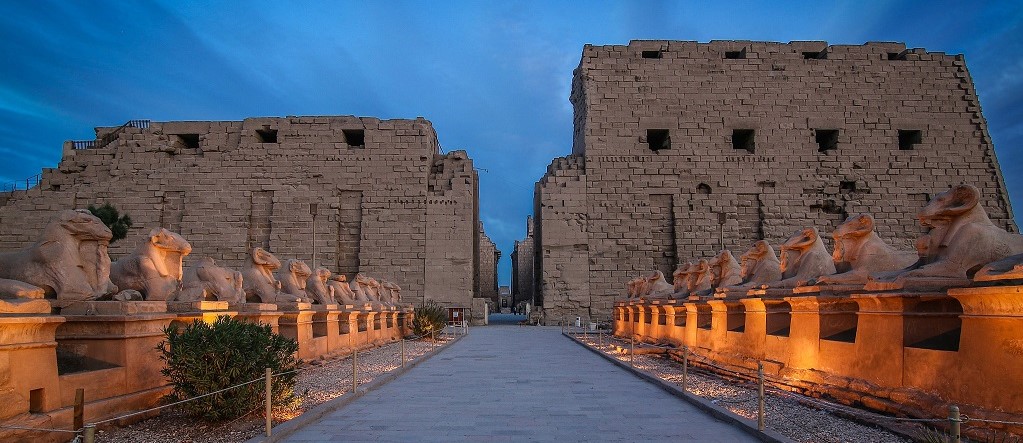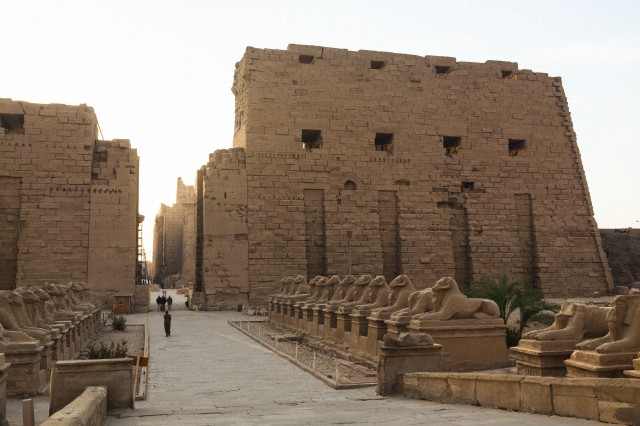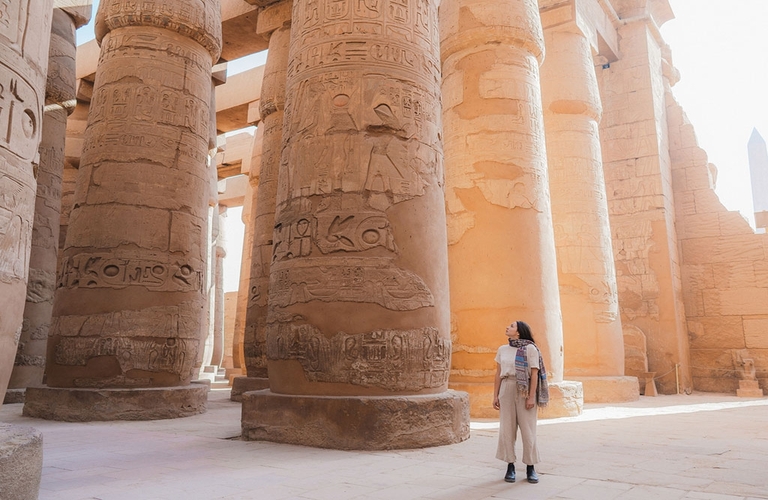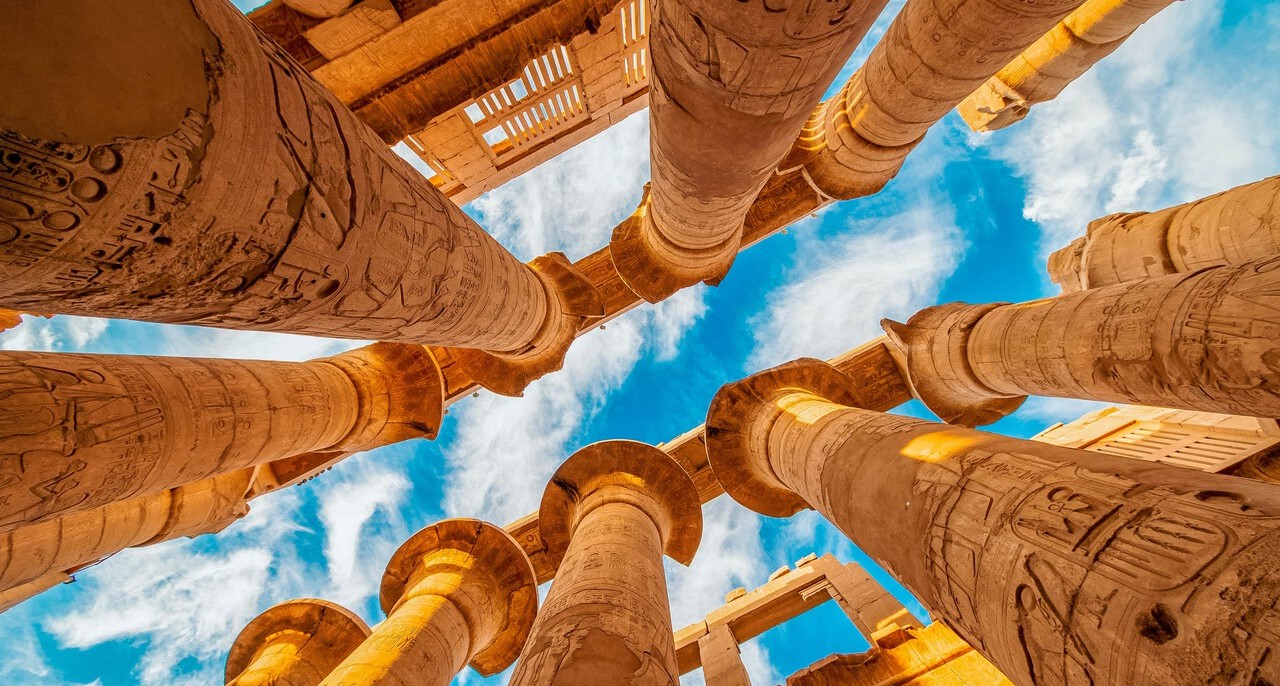Karnak Temple is located near the modern-day city of Luxor on the east bank of the Nile River in Luxor. It is one of the largest and most impressive religious sites in ancient Egypt. It stands as a towering testament to the ingenuity, spirituality, and grandeur of ancient Egyptian civilization. Spanning over 2,000 years of history, from the Middle Kingdom to the Ptolemaic period, and encompassing an area of more than 200 acres, Karnak is not merely a temple but a sprawling architectural marvel, comprising temples, chapels, pylons, obelisks, and other structures that dedicated to the worship of various deities, with Amun-Ra as the primary god and the goddess Mut and their son Khonsu.

The Architecture of the Karnak Temple
Stepping into the sacred precincts of Karnak Temple, visitors strike immediately by the monumental scale and intricate craftsmanship of its structures. At the heart of the complex lies the Great Hypostyle Hall, an awe-inspiring colossal hall adorned with elaborate hieroglyphic inscriptions and relief carvings depicting scenes from Egyptian mythology and religious rituals. The hall is supported by 134 massive columns, some reaching heights of over 20 meters (65 feet), making it one of the largest single-room structures in the world.
Also, starting in the New Kingdom and continuing in the centuries after, Egyptian rulers would gradually create a series of 10 pylons at Karnak. These pylons would function as gateways of sorts; they were connected through a network of walls. The Pylons were often decorated with scenes depicting the ruler who built them.
In addition to the Great Hypostyle Hall and the Pylons, Karnak Temple is home to numerous other architectural wonders, including the Sacred Lake and the Avenue of Sphinxes. The Sacred Lake, an artificial body of water excavated during the reign of Tuthmosis III, served as a site for ritual purification and symbolic reenactments of creation myths.
The Avenue of Sphinxes is a grand processional way lined with hundreds of sphinx statues, connecting Karnak Temple to the nearby Luxor Temple. Originally stretching for over 3 kilometers, this ceremonial avenue served as a symbolic pathway for priests and devotees to traverse between the two temples during religious festivals and processions, further reinforcing the sacred connection between the divine and the earthly realms.

The History of Karnak Temple
Over the centuries, Karnak Temple underwent numerous expansions, renovations, and additions by successive pharaohs and rulers, each seeking to leave their mark on this sacred site. From its origins in the Middle Kingdom to its zenith during the New Kingdom, Karnak reflects the changing religious and political landscape of ancient Egypt.
Under the reign of pharaohs such as Senusret I, who erected the first monumental structures at Karnak, and Amenhotep III, who commissioned some of its most iconic features, Karnak Temple witnessed the construction of monumental structures and the establishment of elaborate religious rituals and ceremonies. However, it was during the reign of Ramesses II, known as Ramesses the Great, that Karnak reached its pinnacle of splendor, with the construction of the iconic pylon gateways, obelisks, and statues that still stand today as enduring symbols of Egypt’s greatness.

The Karnak in the Modern Era
After centuries of neglect and decline, Karnak Temple was rediscovered and excavated by European archaeologists in the 19th century, sparking renewed interest in ancient Egyptian civilization and culture. Since then, efforts have been made to preserve and protect Karnak’s architectural treasures, including the ongoing restoration of its temples and monuments.
Today, Karnak Temple remains one of Egypt’s most popular tourist attractions, drawing visitors from around the world to marvel at its architectural splendor and unravel the mysteries of its sacred past. As a UNESCO World Heritage Site, Karnak stands as a living testament to the enduring legacy of ancient Egypt, inviting visitors to embark on a journey through time and uncover the mysteries of one of the world’s greatest civilizations.
The Sound and Light Show at Karnak
Like all of the major sights in Egypt, Karnak has a sound and light show that takes place 3 times a night and offered in several different languages. It is an unforgettable experience that combines history, mythology, and artistry to create a truly magical evening. The Sound and Light Show at Karnak Temple is more than just a visual feast; it is a captivating storytelling experience that unfolds against the backdrop of one of Egypt’s most iconic archaeological sites. For those fortunate enough to witness it, the Sound and Light Show at Karnak Temple is a night to remember—a journey through the ages that leaves an indelible mark on the soul.

In conclusion, Karnak Temple stands as a timeless monument to the majesty and mystery of ancient Egypt. From its towering columns and monumental gateways to its sacred lakes and processional avenues, Karnak embodies the spiritual and cultural richness of a civilization that continues to captivate the imagination of people around the world.
As visitors explore the hallowed precincts of Karnak, they are transported back in time to an era of pharaohs and gods, rituals, and ceremonies, where the boundaries between the earthly and the divine were blurred. In the shadow of its towering columns and beneath the gaze of its serene statues, Karnak Temple invites us to embark on a journey of discovery and enlightenment, offering a glimpse into the enduring legacy of one of humanity’s greatest civilizations.








Nemo enim ipsam voluptatem quia voluptas sit aspernatur aut odit aut fugit, sed quia consequuntur magni dolores eos qui ratione voluptatem sequi nesciunt.
Duis aute irure dolor in reprehenderit in voluptate velit esse cillum dolore